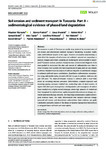Soil erosion and sediment transport in Tanzania: Part II – sedimentological evidence of phased land degradation
| dc.contributor.author | Wynants, Maarten | |
| dc.contributor.author | Patrick, A | |
| dc.contributor.author | Munishi, L | |
| dc.contributor.author | Mtei, K | |
| dc.contributor.author | Bodé, S | |
| dc.contributor.author | Taylor, A | |
| dc.contributor.author | Millward, G | |
| dc.contributor.author | Roberts, C Neil | |
| dc.contributor.author | Gilvear, David | |
| dc.contributor.author | Ndakidemi, P | |
| dc.contributor.author | Boeckx, P | |
| dc.contributor.author | Blake, William | |
| dc.date.accessioned | 2021-10-14T12:53:33Z | |
| dc.date.available | 2021-10-14T12:53:33Z | |
| dc.date.issued | 2021-12 | |
| dc.identifier.issn | 0197-9337 | |
| dc.identifier.issn | 1096-9837 | |
| dc.identifier.uri | http://hdl.handle.net/10026.1/18067 | |
| dc.description.abstract |
<jats:title>Abstract</jats:title><jats:p>Soil resources in parts of Tanzania are rapidly being depleted by increased rates of soil erosion and downstream sediment transport, threatening ecosystem health, water and livelihood security in the region. However, incomplete understanding to what effect the dynamics of soil erosion and sediment transport are responding to land‐use changes and climatic variability are hindering the actions needed to future‐proof Tanzanian land‐use practices. Complementary environmental diagnostic tools were applied to reconstruct the rates and sources of sedimentation over time in three Tanzanian river systems that have experienced changing land use and climatic conditions. Detailed historical analysis of sediment deposits revealed drastic changes in sediment yield and source contributions. Quantitative sedimentation reconstruction using radionuclide dating showed a 20‐fold increase in sediment yield over the past 120 years. The observed dramatic increase in sediment yield is most likely driven by increasing land‐use pressures. Deforestation, cropland expansion and increasing grazing pressures resulted into accelerating rates of sheet erosion. A regime shift after years of progressive soil degradation and convergence of surface flows resulted into a highly incised landscape, where high amounts of eroded soil from throughout the catchment are rapidly transported downstream by strongly connected ephemeral drainage networks. By integrating complementary spatial and temporal evidence bases, this study demonstrated links between land‐use change, increased soil erosion and downstream sedimentation. Such evidence can guide stakeholders and policy makers in the design of targeted management interventions to safeguard future soil health and water quality.</jats:p> | |
| dc.format.extent | 3112-3126 | |
| dc.language | en | |
| dc.language.iso | en | |
| dc.publisher | John Wiley and Sons | |
| dc.subject | climate change | |
| dc.subject | East Africa | |
| dc.subject | land degradation | |
| dc.subject | land-use change | |
| dc.subject | radiometric dating | |
| dc.subject | sediment connectivity | |
| dc.subject | sediment fingerprinting | |
| dc.title | Soil erosion and sediment transport in Tanzania: Part II – sedimentological evidence of phased land degradation | |
| dc.type | journal-article | |
| dc.type | Journal Article | |
| plymouth.author-url | https://www.webofscience.com/api/gateway?GWVersion=2&SrcApp=PARTNER_APP&SrcAuth=LinksAMR&KeyUT=WOS:000701325500001&DestLinkType=FullRecord&DestApp=ALL_WOS&UsrCustomerID=11bb513d99f797142bcfeffcc58ea008 | |
| plymouth.issue | 15 | |
| plymouth.volume | 46 | |
| plymouth.publication-status | Published | |
| plymouth.journal | Earth Surface Processes and Landforms | |
| dc.identifier.doi | 10.1002/esp.5218 | |
| plymouth.organisational-group | /Plymouth | |
| plymouth.organisational-group | /Plymouth/Admin Group - REF | |
| plymouth.organisational-group | /Plymouth/Admin Group - REF/REF Admin Group - FoSE | |
| plymouth.organisational-group | /Plymouth/Faculty of Science and Engineering | |
| plymouth.organisational-group | /Plymouth/Faculty of Science and Engineering/School of Geography, Earth and Environmental Sciences | |
| plymouth.organisational-group | /Plymouth/REF 2021 Researchers by UoA | |
| plymouth.organisational-group | /Plymouth/REF 2021 Researchers by UoA/UoA14 Geography and Environmental Studies | |
| plymouth.organisational-group | /Plymouth/Research Groups | |
| plymouth.organisational-group | /Plymouth/Research Groups/Marine Institute | |
| plymouth.organisational-group | /Plymouth/Users by role | |
| plymouth.organisational-group | /Plymouth/Users by role/Academics | |
| plymouth.organisational-group | /Plymouth/Users by role/Researchers in ResearchFish submission | |
| dcterms.dateAccepted | 2021-08-07 | |
| dc.rights.embargodate | 2021-10-15 | |
| dc.identifier.eissn | 1096-9837 | |
| dc.rights.embargoperiod | Not known | |
| rioxxterms.versionofrecord | 10.1002/esp.5218 | |
| rioxxterms.licenseref.uri | http://www.rioxx.net/licenses/all-rights-reserved | |
| rioxxterms.licenseref.startdate | 2021-12 | |
| rioxxterms.type | Journal Article/Review | |
| plymouth.funder | "International". Jali Ardhi [Care for the Land] project: Realising land management change in degraded Maasai grazing lands.::NERC | |
| plymouth.funder | "International". Jali Ardhi [Care for the Land] project: Realising land management change in degraded Maasai grazing lands.::NERC | |
| plymouth.funder | "International". Jali Ardhi [Care for the Land] project: Realising land management change in degraded Maasai grazing lands.::NERC |


